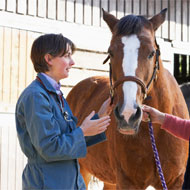Equine practice: the importance of health and safety

Stress is the most common cause of long-term sickness absence.
Caroline Crowe and Lesley Tench presented this topic in the equine section at the VPMA/SPVS Congress.
Caroline gave an overview of stress in veterinary practice and suggested that for equine vets there is extra stress - not only from visits, but also the dangers involved with equine practice.
A recently commissioned BEVA study showed that equine vets have the highest instance of any civilian occupation of injuries including, bruising, fractures and lacerations.
The survey looked at 600 equine vets and found that 25 per cent had sustained some form of injury mainly to the leg or head. The main causes of injury were kicks and crush injuries, with 49 per cent having had kicks from hind limbs. 25 per cent of injuries required hospitalisation.
Other typical hazards of equine practice include: musculoskeletal, plus cuts, lacerations, biological hazards, radiation, aggressive animals and, last but by no means least, the working environment - both in the practice and on the owners property.
Caroline concentrated on the causes of stress in practice, citing time, diary juggling, extra work, team dynamics, driving and isolation to name just a few.
Stress is the most common cause of long-term sickness absence causing both practical and financial problems within the practice. It has been recorded that 26 per cent of vets suffer anxiety and five per cent suffer from clinical depression.
Add the risk of injury to the potential stress that vets in equine practice may encounter and it can be seen that the need for a robust health and safety policy in equine practice is essential.
There are four health and safety legal obligations: The Health and Safety at Work Act 1974, The Management of Health and Safety at Work Regulations 1999, The Equality Act 2010 and The Health and Safety Management Standards.
The importance of having a health and safety policy which has carried out rigorous risk assessments in all areas of employee health and safety “cannot be overemphasised,” said Caroline.
Most practices will have their own health and safety policy. Indeed the Practice Standards Scheme demands this, but it can do no harm to revisit your policy especially within the equine environment just to make sure that everything is up to speed.



 BSAVA is to partner with BVA Live (11-12 June 2026) to champion clinical research.
BSAVA is to partner with BVA Live (11-12 June 2026) to champion clinical research.